FDOT's Work Zone Fatality Reduction Strategies
slide 1: FDOT's Work Zone Fatality Reduction Strategies
- Motorist Awareness System (MAS)
- Temporary Raised Rumble Strips for Flagging Operations
- In-depth Process Reviews/Training
- Public Service Announcements
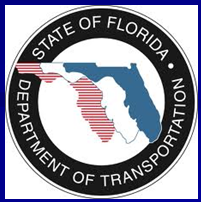
[PDF version, 467 KB]
PDF files can be viewed with the Acrobat® Reader®.
slide notes:
For years, Florida has been one of the top three states with the most fatalities in the work zone. This is one category that Florida is not proud to number 1 in.
A few strategies that Florida has implemented in the past few years that may have contributed to a reduction in fatalities are:
1 – Implementation of the Motorist Awareness System
2 – Temporary Raised Rumble Strips for Flagging Operations
3 – More in-depth Process Reviews, which includes training
4 – Public Service Announcements
slide 2: FDOT's Motorist Awareness System (MAS)
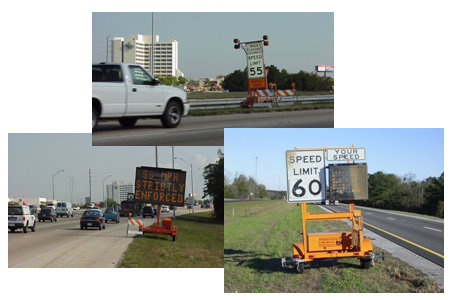
slide notes:
I will start first by explaining what the Motorist Awareness System or MAS is.
slide 3: What is the Motorist Awareness System (MAS)?
- Addition of 5 components to a standard lane closure
- Goal: Achieve same respect for Work Zones that Florida's School Zones currently received. Reduce speed in work zone where workers are present
slide notes:
In 2003, a review of Florida's fatalities revealed that approximately 45% of the fatalities were contributed to excessive speed in the work zone. So we thought if we could just reduce speed in the work zones, it would also reduce fatalities.
The MAS is the addition of five components to a standard lane closure setup.
The goal of the Motorist Awareness System (MAS) is to achieve the same respect for Work Zones that Florida's School Zones currently receive. Florida School Zones receive high compliance for the speed limit, with and without law enforcement present.
We felt that the key to achieving this respect was to discontinue blanket speed limit reductions in work zones, increase enforcement, and to remove the MAS when the conditions requiring it no longer exist and restore the speed limit within the limits of the project to the posted speed limit. Specifically, MAS components would be activated when the lane closure is setup and deactivated when the lane closure is taken down.
slide 4: When to use MAS?
(All conditions must be met)
- Multilane facility
- Posted speed limit is 55 mph or greater
- Work operation requires a lane closure
- Workers are present
slide notes:
When do we use the MAS?
There are four conditions that warrant the use of the MAS are:
1 – Work zone facility is a multilane
2 – It would be a High speed work zone facilities, posted 55 mph or greater
3 – Work zones consists of a work operation that requires a lane closure
4 – Work zones had to have workers present
slide 5: What Devices are used?
Changeable Message Sign notifies motorist of speed reduction
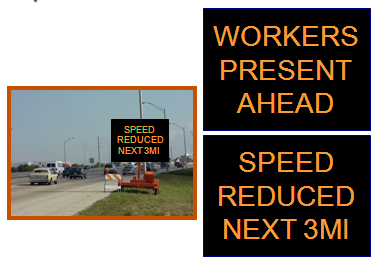
slide notes:
The next few slides will explain a little more of the devices used for the MAS.
The first additional device is the Changeable Message Sign. This is an appeal to the motorist to reduce their speed, because workers are present, and it will only be for 3 miles.
slide 6: Where to place CMS device
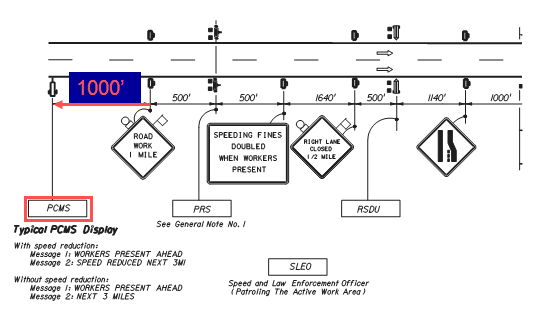
slide notes:
The Portable Changeable Message Sign is placed 1000 feet in advance of the "Road Work 1 mile" advance warning sign.
The Portable Changeable Message Sign is trailer mounted display used to warn motorists that workers are present ahead and the speed is reduced for the next 3 miles. The maximum lane closure is two miles; however, it takes about a mile in advance of the lane closure to reduce the speed, hence the 3 mile reduction of speed.
slide 7: What devices are used?
Portable Regulatory Sign (PRS)
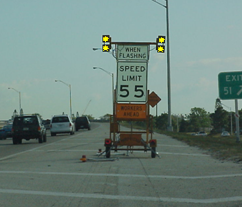
slide notes:
Two (2) Portable Regulatory Signs are used.
Because the system is only used on multilane projects, we use two portable regulatory signs. One is placed in the median and the other is placed directly across, on the outside shoulder.
The Portable Regulatory Signs are trailer mounted regulatory speed limit signs with flashing lights used to inform motorists of the new speed limit for the work zone. The speed is reduced 10 mph below the posted speed limit, but not below 55 mph.
slide 8: Where to place PRS devices
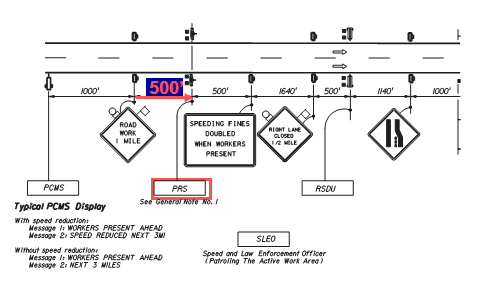
slide notes:
The Portable Regulatory Signs are placed between the "Road Work 1 mile" sign and the "Speeding Fines Doubled when Workers Present" sign.
slide 9: What devices are used?
Radar Speed Display Unit (RSDU)
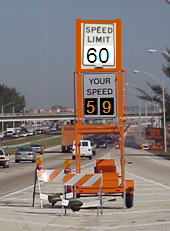
slide notes:
Two (2) Radar Speed Display Units are used.
As mentioned before about the portable regulatory signs, because the system is only used on multilane projects we use two radar speed display units. One is placed in the median and the other is placed directly across, on the outside shoulder.
The Radar Speed Display Units are trailer mounted units containing radar that detects and displays the speed of motorists as they approach the lane closure.
slide 10: Where to place RSDU devices
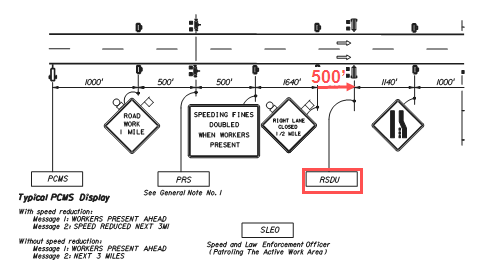
slide notes:
The Radar Speed Display Units are placed 500 feet after the "Right Lane Closed ½ Mile" advance warning sign.
slide 11: Motorist Awareness System
- Speed and law enforcement officers are used randomly to enforce the reduced speed in the work zone
slide notes:
In addition to the five components mentioned, speed and law enforcement officers are used randomly to enforce the reduced speed in the work zone.
slide 12: Costs of Devices for FDOT's MAS
- Changeable Message Signs
- $12.30 per day
- Portable Regulatory Signs
- $6.03 per day per sign
- Radar Speed Display Units
- $6.31 per day per sign
slide notes:
The past six months average cost for the devices used in the MAS is:
Changeable Message Signs average a cost of $12.30 per day – started out paying $45 per day
Portable Regulatory Signs average a cost of $6.03 per day per sign – 2 used per day – started out paying $40 per day
Radar Speed Display Units average a cost of $6.31 per day per sign – 2 used per day – started out paying $35 per day
slide 13: Research Study Evaluating FDOT's MAS
- Speed reduced average of 4 to 5 mph
- Research Study Link:
http://www.dot.state.fl.us/research-center/Completed_Proj/Summary_SF/BD500/BD500_v4_rpt.pdf
slide notes:
FDOT's Safety Office conducted research that concluded that when using the MAS an average of 4 to 5 mph reduction in the work zone speed limit was achieved.
Here is the link to the research.
slide 14: Where to get more information on the MAS
- FDOT Design Standard Index 670: http://www.dot.state.fl.us/rddesign/DS/12/IDx/00670.pdf
- State Construction Office: http://www.dot.state.fl.us/construction/memos/2005/DCE06-05.pdf
slide notes:
The FDOT Design Standard and the memo that we used to implement the MAS can be found at these links.
slide 15: Temporary Raised Rumble Strips for Flagging Operations
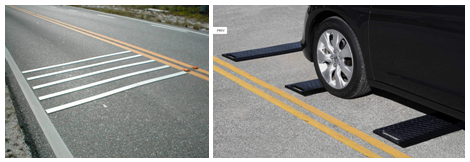
slide notes:
The second strategy implemented by Florida is the use of temporary raised rumble strips for flagging operations.
These rumble strips supplement the advanced warning signs. Here are two examples of the kinds of rumble strips that have been used in Florida. The left picture is the removable polymer rumble strip, and is required to be:
- 250 mil or .25 inch thick
- 4 inch wide
- 11 feet long
The right picture is the Molded Engineered Polymer Rumble Strips, and is:
- 1 inch High
- 12 inches wide
- 11 feet long
- weighs 100 lb, does not require anchoring and is reusable.
slide 16: Temporary Raised Rumble Strips for Flagging Operations
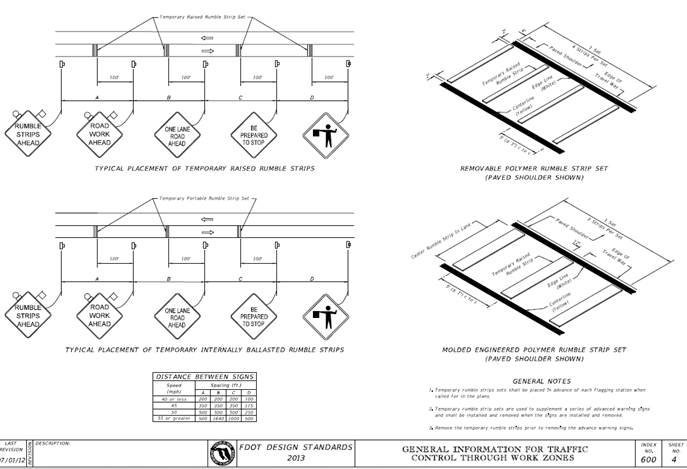
slide notes:
This is Florida's Design Standard.
When using the removable polymer rumble strip – 4 sets of 4 are required.
When using the molded engineered polymer rumble strip – 3 sets of 3 are required.
slide 17: Temporary Raised Rumble Strips for Flagging Operations
PLANS PREPARATION MANUAL
|
10.12.16 Temporary Raised Rumble Strip Sets Temporary raised rumble strips should be considered in addition to normally used warning signs/devices on the approach to flagging operations where additional alertness is desired of drivers approaching flagging operations. Work zones in an isolated location or with sharp horizontal or vertical curves may benefit from the additional advance warning by alerting drivers visually, audibly, and tactilely of the approaching work zone. |
slide notes:
The temporary raised rumble strips are used if additional driver alertness is needed for example at Limited stopping sight distance at horizontal and vertical curves.
slide 18: FDOT's In-depth Process Reviews/Training
- Multidiscipline team performs review
- Review 3 projects per district and 4 districts per year
- Conduct hands on training in districts
- Current training topic – crash cushions
slide notes:
The third strategy that FDOT has recently implemented is performing In-depth Process Reviews/Training.
FDOT's process review team consist of an specialty engineer from our Design office, our Construction office, and the Florida Division FHWA office.
The team reviews three projects per district. We review half the districts per year. We have 8 districts.
Conducting the process reviews provides the insight to where the districts need more focus and where we find the need for training. We are currently focusing on crash cushions. Here are a few pictures from some of the training that we have conducted.
In addition to going out onto individual projects and performing process reviews, we also conduct hands on training for large groups while we are in the districts. We have received extremely positive feedback from all of our districts and industry. The training is free to FDOT employees, consultants, contractors, etc.
slide 19: Public Service Announcements
http://www.itseveryonesjob.com/index.shtml
slide notes:
The fourth strategy is the use of Public Service Announcements
Each year the FDOT Safety Office creates tip cards for Work Zone Awareness Week. This is an example of one of the tip cards used. The tip cards along with the US DOT Work Zone Safety Posters are distributed to all District Public Information Offices (PIO's) and Community Traffic Safety Teams & posted to the FDOT Work Zone Safety website www.itseveryonesjob.com. The FDOT Public Information Office filmed a Public Service Announcement (PSA) which is posted on this same website, and the PSA is also played on a loop at all of the State of Florida Welcome Centers. The Public Information Office also sends out a statewide press release for Work Zone Safety Week.
Next is the video of the Public Service Announcement that FDOT uses for Work Zone Awareness Week.
slide 20: Public Service Announcements
http://www.itseveryonesjob.com/index.shtml
slide notes:
Here is a video of the Public Service Announcement that FDOT uses for Work Zone Awareness Week.
slide 21: Fatality Analysis Reporting System (FARS)
| Year | US | FL |
|---|---|---|
| 2005 | 1074 | 162 |
| 2006 | 1004 | 118 |
| 2007 | 835 | 92 |
| 2008 | 720 | 81 |
| 2009 | 680 | 82 |
| 2010 | 576 | 43 |
slide notes:
You can see in this table, from the Fatality Analysis Reporting System, in 2005 Florida's work zone fatalities were at 162 and in 2010, we have dropped down to 43.
slide 22: Questions ???
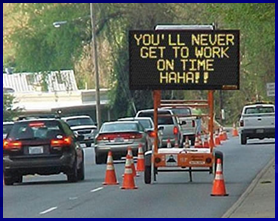
slide notes:
Any questions?
slide 23: Contact for more information
Ezzeldin Benghuzzi, P.E.
Phone: 850-414-4352
Email: Ezzeldin.Benghuzzi@dot.state.fl.us
Stefanie D. Maxwell, P.E.
Phone: 850-414-4314
Email: Stefanie.Maxwell@dot.state.fl.us